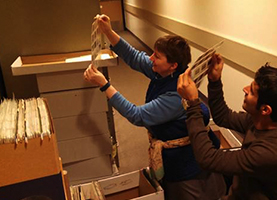What should I do with the boxes of family stuff in great-aunt Susie’s attic or garage? Is it archival? Should I laminate or digitize it? These are typical questions I am often asked. Here are some answers.

Archival collections are informational collections of permanent historic research value created directly by a person, family, or organization. Collections could be letters, photos, minutes, drafts of stories, scrapbooks, account ledgers, home movies, emails, etc. A collection may be one letter or millions of images. Archivists collect, physically preserve and intellectually describe archival collections making them accessible to researchers through cataloging and finding aids. Retaining the original primary source is imperative to archivists to prove the veracity, integrity, and origin of the collection as a reliable research source.
Most information is NOT archival. Don’t waste your time, energy and resources on expensive storage options for short-term information like working files, miscellaneous financials or notes, drafts, or generic correspondence. For organizational records check with your parent organization and ask if there is a records schedule and who is responsible to retain the master copy.

For collections of long term value to you, your family or organization, but not necessarily to researchers, here are some basic preservation tips:
- The #1 best preservation step you can take is to provide a stable, secure storage environment that is cool and dark, with air flow and constant humidity between 35-50%. Heat, light and fluctuating or high humidity levels speed decomposition of most formats. Do not eat or drink around these items as drips and crumbs attract paper eating critters, damaging collections.
- Do not laminate anything of long-term value! Your family pictures will be severely damaged and discolored if you laminate them.
- Store materials three inches above the floor. The most common disaster for collections is water damage. Because it will take time for water, or any other type of liquid, to cover an entire floor, and even longer to rise three inches, three inches will usually keep your materials dry or give you time to move them before they are damaged.
- Avoid storing valuable items in attics, sheds, basements, garages and storage units as these spaces usually have unstable environments.
Paper-based collections:
- Scan or photocopy highly acidic late 19-20th century newspapers clippings. A copy on acid-free paper will last much longer than the original.
- Store paper-based collections in acid-free folders vertically and in acid-free boxes, which are available in many stores. Do not pile large or heavy items above smaller or lighter-weight materials.
Images:
- Keep images out of direct light and never touch them without wearing gloves, especially when handling negatives, as the oil from your hands will damage the image. Use inert polypropylene sleeve, not basic plastic, for images and store negatives in acid-free envelopes.
- If you have questions about how to archive moving image film, like home movies, please contact me.
Machine-readable records:
- Most archives, including the Clarke Historical Library archive, find it more economical to accrue used equipment to access the most common types of older formats rather than pay a vendor to reformat. The Clarke has a reel-to-reel player, CD player, VHS player, microcassette player, a record player, a Sony camera for microcassette videos, and film projectors.

One of the biggest issues for all archives is inaccessible formats which result in inaccessible, or lost data. Hard, floppy or compressed discs are no longer accessible at Central Michigan University, yet I still receive them in collections. Nationally we have lost vast amounts of data from the late 20th century forward.
Digital:
The archival profession does NOT consider digital a permanent, archival storage format. Digital is temporary and continues to rapidly evolve. Digital is not secure, as it is easy to hack, edit, delete or corrupt files. It is standard archival practice when we digitize a collection to generate both paper and digital backup files to be sure the information will remain intact and accessible in the future. Acid-free paper in an archival environment will last 100 years and is easily read or accessed without a computer or other machine. Archives digitize collections to increase accessibility and to decrease wear and tear on the originals so they will last longer. We do not digitize a collection and then dispose of the originals. There is no such thing as digital preservation. If you have digital files you must retain, the best option now is to make multiple backup copies.
Digitizing a manuscript collection is very time consuming and expensive. Quality digitizing requires equipment, trained staff following standards and best practices, and quality control. To assist researchers, systematic, high-quality descriptive metadata must be created and added to each digital item. This is a very time consuming and expensive process. With manuscripts, Optical Character Recognition (OCR) often does not read handwritten manuscripts well. Most include various color pages, attachments, ink and or pencil marks, as well as damage from acid stains and deterioration, all of which are challenges to generating a good digital image.
Lastly, quality, secure, digital storage for archival collections is expensive and must be maintained and accessible for future generations of researchers. The long-term cost of digital storage is a major factor when deciding what to digitize. Who pays for digital storage and how much the archives or universities charge donors or clients for digital services are all complex issues.

Please contact me if you have questions. Archives rock! Marian Matyn, marian.matyn@cmich.edu, (989) 774-3990.

